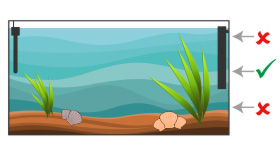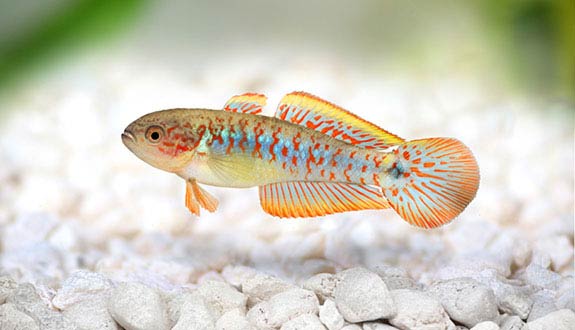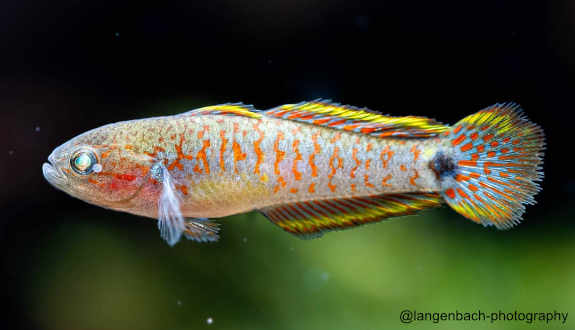

Alternative species (click on the thumbnail to see the card)
Names
Scientific name
Tateurndina ocellicauda
Common name
Peacock gudgeon
Peacock-eye gudgeon
Peacock goby
Origin

Origin: Australia/New Guinea
Biotope: New Guinea
Dimorphism

Not very clear. The male is more colourful and has a more prominent «forehead”
Group

Eleotridae
Volume

40 L / 9 imp gal / 10 US gal
Parameters

T°: 24 à 26°C or 75 to 79°F
pH: 6.5 to 7.5
Hardness: 5 to 10°dGH
Difficulty

Average
Size

4 to 6cm (1.6 to 2.4")
Longevity

5 to 7 years
Living zone

Middle
Individuals

Couple or harem
Food
How to feed the Peacock gudgeon?
Food
How to feed the Peacock gudgeon?
The Peacock Gudgeon is mainly insectivorous and vermivorous. It will eat dry foods but it would be better to feed it with live or frozen prey: tubifex, bloodworms, Grindal worms, Artemia. This fresh and varied diet will encourage a beautiful colouring.
Behavior
What kind of behavior does the Peacock gudgeon have?
Behavior
What kind of behavior does the Peacock gudgeon have?
The Peacock Gudgeon is a peaceful fish and quite shy. It is very calm, it is from there that it derives its nickname «sleeper». If maintained in a group of several individuals, you will be able to observe interesting interspecific relationships.
Cohabitation
Who can live with the Peacock gudgeon?
Cohabitation
Who can live with the Peacock gudgeon?
This species can live as a couple or as a harem. Maintenance in harem is preferable because that is how it lives naturally (in this case, we will maintain 1 male for 2 or 3 females). In addition, it will tend to be more active if it lives with several of its congeners, rather than couples. If you want to maintain several pairs together, you will need a much larger aquarium because this fish is territorial with the members of its species during laying.
Because of its very shy nature, we recommend a specific aquarium.
However, if you wish to add other species, the ideal will be to maintain it with other fish from its biotope (Papua New Guinea), such as rainbow fish. Otherwise, the Corydoras, the Rasboras, and in general all the calm and peaceful fish of small size can also be considered. Note however that it is better to introduce the Peacock Gudgeon last in your community aquarium.
Cohabitation with small live fish is discouraged, as well as with winged species. Similarly, avoid large species that could intimidate our Peacock Gudgeon. Finally, cohabitation with territorial fish is also to be banned (especially cichlids).
Breeding
How to breed the Peacock gudgeon?
Breeding
How to breed the Peacock gudgeon?
The breeding of the Peacock Gudgeon is possible. For more luck, you can maintain several individuals (from 6 to 8), the couples will then form naturally.
To stimulate lovers, feed them with live and varied prey. Then make a change of water. This should trigger the breeding process. The water parameters recommended for reproduction are a temperature of 26°C or 79°F and a pH of 7.
When the female wears eggs, its abdomen becomes yellow / orange and its dorsal and anal swims wear a black liseret. Before spawning, the male courts the female by making beautiful parries and seems to «dance» around her by deploying her fins. It will try to attract the female to the nesting place.
Spawning usually takes place in a cavity (coconut, bamboo, root hole...) or under large leaves. The ideal is the use of a PVC tube plugged at one end. This pipe will be short and of sufficient width (x1.5 the head of the male). It will also be leaning (not just laid horizontally).
The female will lay the eggs on the walls and the male will fertilise them immediately. Then, the male hunts the female and will take care of monitoring and ventilating the eggs. The hatching takes place in 2 to 4 days. The fry are already born quite self-sufficient and of respectable size. Their growth is slow. For the best fathers, they will accompany the little ones until the resorption of their yolk sac and their free swimming.
In this regard, to avoid the predation of the parents, you can raise the fry in a separate aquarium (take them between oviposition and hatching, the second day for example.) Be careful that the eggs do not enter in contact with the air, even 1 second: they must remain submerged constantly). You will take care to have started this breeding tank some time before the introduction of fry. This will allow the installation of a micro-fauna that will serve as food for the little ones. Alternatively, remove all fish from the bin after spawning.
Fry food: nauplies of artemia and micro-worms.
Its aquarium
Which aquarium for the Peacock gudgeon?
Its aquarium
Which aquarium for the Peacock gudgeon?
Despite its small size, opt for an aquarium of at least 40 liters or 9 imp gal or 10 US gal, if you keep it specific. Indeed, this fish does not require a lot of space because it is not a very good swimmer. If you choose roommates, you will need to provide a larger aquarium.
The Peacock Gudgeon likes very planted bins. Indeed, its shy nature drives him to hide. Dense vegetation, floating plants and subdued lighting reassures him. To further reinforce this sense of security, put a dark substrate. The roots are also welcome. Finally, do not forget to set up a nesting place. For example, you can opt for a short enough wide PVC pipe or a hollow wood such as bamboo, closed on one side and firmly embedded in the substrate, not horizontally. This is essential because otherwise the fish will remain prostrate and inactive. The more the fish will feel at ease, the more they will show themselves and the more they will sport a very beautiful colour!
Be careful not to subject your fish to too much current. Indeed, the Peacock Gudgeon is not a very good swimmer and is not very enduring. It will run the risk of being exhausted by a constant current. Choose the minimum filtration with good water quality, and break the current by directing the filter outlet against a window of the tank. To ensure optimal water quality, make a water change of 20% each week.
Remember to always cover the Peacock Gudgeon tank because it is likely to jump out of the water.
Good To know
Find all additional information!
Good To know
Find all additional information!

Many think it is a Goby, when it is not! It is a species of the family Eleotridae.
It can be quite difficult to find this species commercially. Get in touch with specialised stores and aquarium hobby clubs to get them.
Yours photos!
Comments
Sort by:
Please login to post comments

